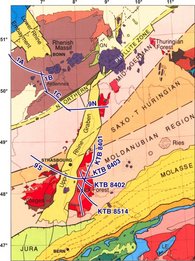Deep seismic investigations across the Upper Rhine Graben
The European Variscides, extending from the French Central Massif to the East European Platform, originated during the collision between Gondwana and Baltica in the Late Palaeozoic. Due to involvement of various crustal blocks in the orogenesis, the mountain belt is sub-divided into distinct zones. The external fold-and-thrust belts of the Rhenohercynian (RH) and Saxothuringian (ST) as well as the predominantly crystalline body of the Moldanubian (MN) dominate the central European segment of the Variscides. Polyphase tectonic deformation, magmatism and metamorphic processes led to a complex interlinking between the units.
The survey DEKORP 9 was shot across the Tertiary Upper Rhine Graben, which intersects both the Saxothuringian and Moldanubian regions obliquely. These regions are separated by the SW-NE striking Lalaye-Lubine-Baden Baden shear zone which is marked in the northern Vosges and Black Forest massifs by low-grade Devonian metasediments. Since the Eocene the Rhine Graben represents an active rift system
The seismic survey of DEKORP 9 aimed
- to delineate the geometry of the major faults which control the graben subsidence,
- to map the geometry of deep crustal reflection patterns,
- to reveal variations of the seismic signature of the lower crust in the context of rift formation.
In 1988 the seismic experiments of DEKORP 9 were performed in two parts as a joint venture of the French ECORS and the German DEKORP groups. The DEKORP 9N profile runs within the Saxothuringian unit and extends the DEKORP 1 profile from the Permian Saar-Nahe Basin to the crystalline Odenwald. DEKORP 9S is the western continuation of line KTB 8403. It crosses the Upper Rhine Graben in its southern part and traverses the Variscan units from the Mid-German Crystalline High (Saxothuringian) to the crystalline massif of the Black Forest in the Moldanubian (see location map).
Experiments
DEKORP 9N:
The 92 km long, E-W trending profile crosses the northern part of the Upper Rhine Graben. It starts in the crystalline Odenwald, crosses the Tertiary and Quarternary fill of the Rhine Graben and ends in the late Palaeozoic sequences of the Saar-Nahe Basin in the west. There it crosses the Permian rhyolitic Donnersberg intrusion.
DEKORP 9S:
DEKORP 9S has a length of 139 km and crosses the southern portion of the Upper Rhine Graben. The line starts in the Black Forest, where it is connected to the deep reflection seismic line KTB 8403. Then it crosses the Upper Rhine Graben and the Vosges Mountains perpendicularly and turns northwestward. DEKORP 9S ends in the Lorraine Basin.
long (start) lat (start) long (end) lat (end)
DEKORP 9N 7.65563 49.65272 8.92294 49.66937
DEKORP 9S 6.66938 48.91938 8.09921 48.28243



